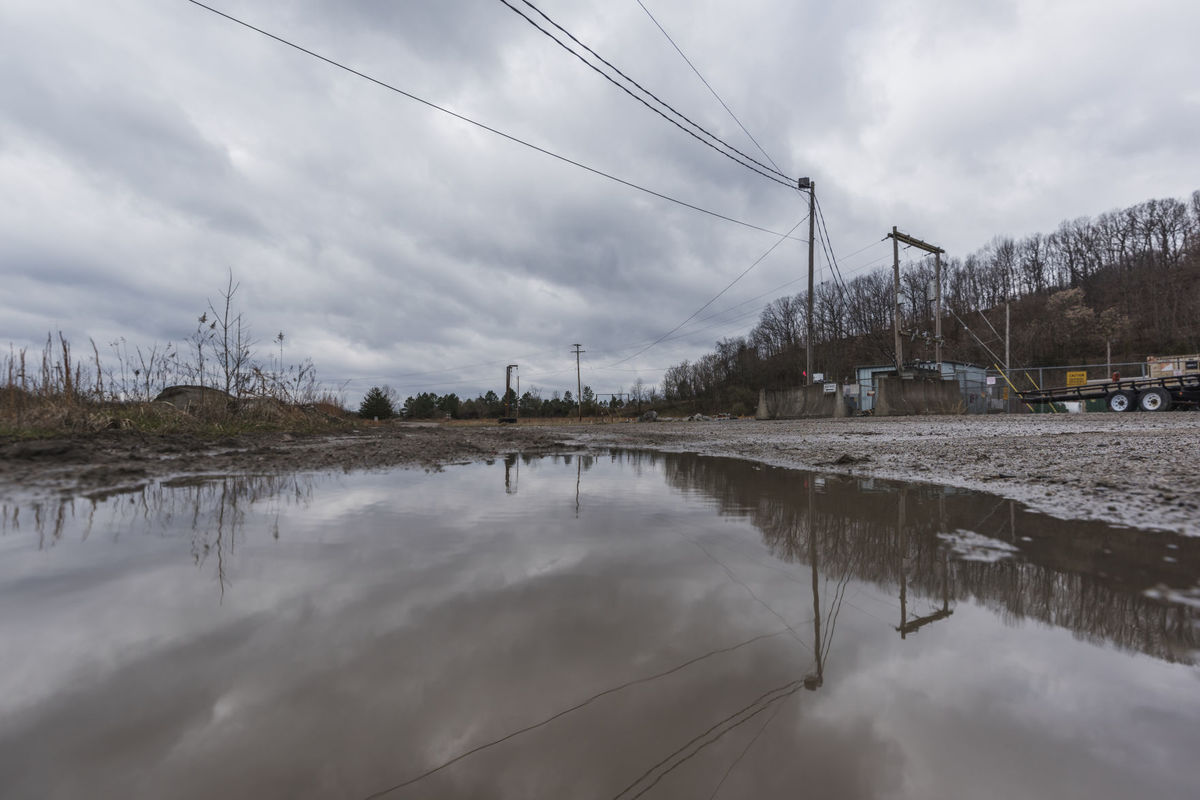West Virginia National Guard the First Step in Hobet Reuse Efforts

By Caity Coyne
March 18, 2018 - In his 2016 State of the State address, then-Gov. Earl Ray Tomblin vowed that the 12,000 acres of land at the Hobet 21 mine, left flattened by years of surface mining, would become “the largest industrial site in West Virginia history.”
Today, it holds a training installation for the West Virginia National Guard, presenting a change in direction, albeit not completely, from Tomblin’s 2016 plan.
“Nothing we’re doing at Hobet infringes on the potential of manufacturing or other industries coming here in the future,” said West Virginia National Guard Maj. Gen. James Hoyer. “If we do this right, it creates opportunity across the spectrum.”
Now called the Rock Creek Development Park, the mine land sprawls between Boone and Lincoln counties and is impossible to miss from four-lane Corridor G. Coal waste sits near the entrance to a haul road, which winds up the mountain.
Hoyer said the lay of the land at the former surface mine provides a rare opportunity for mobility training. The open space can hold sand pits, where guardsmen train to drive military-grade vehicles in environments similar to those where combat takes place. It also provides a closer training opportunity for the National Guard units in West Virginia, many of which currently have to travel to Virginia for training weekends.

National Guard officials say the terrain at Hobet - now called Rock Creek Development Park - can help train guardsmen in driving and mobility techniques that are hard to recreate in other places.
Photo by Craig Hudson, Gazette-Mail
“We’re giving our guardsmen back some precious time with their families and more training time. It’s given us a unique opportunity to better train,” Hoyer said. “It also makes it easier and more accessible for our young people. We’ve got to get our focus back on training them in austere environments — which can be present here. It’s absolutely criminal if we don’t train our younger people.”
National Guardsmen have been working at the site since November, after talks between Hoyer, Gov. Jim Justice and other state agencies moved the focus of the project from industry to military.
In December, Justice scrapped an integral part of Tomblin’s plans for the development — a $100 million four-lane highway that would directly link it with Corridor G. Instead, Justice announced the state would spend $30 million to upgrade the haul road, a project Hoyer said will be underway soon.
The change had its costs. In 2016, the state sold $58 million in Grant Anticipation Revenue Vehicle bonds to afford the 2.6 miles of highway. News reports at the time quoted Brent Walker, Department of Highways spokesman, saying those bonds could not be used for any other project, something Hoyer said he still believes is true.
Walker did not return requests for comment.
When Justice’s new plans for the site went public, state Sen. Ron Stollings, D-Boone, said he was alarmed by what it would mean for his constituents and the potential for economic development in the county.
“I was hoping that it would just move forward as planned, you know that was plan A, and this — updating the haul road, that was my plan B,” Stollings said. “If we can’t have plan A, I’ll take plan B.”
In Tomblin’s original plan, the site would have catered first and foremost to what Stollings was passionate about: businesses and potential manufacturing plants — “including Toyota, Proctor & Gamble, Gestamp, Macy’s, Amazon and more,” Tomblin said.A lack of communication about the plans had Stollings — and his constituents — vocally upset.
“When my people heard about the military moving in there and nothing about manufacturing, they were raising all kinds of Hades,” Stollings said. “They were absolutely livid when they thought it was just military training. I’ve never heard such a visceral response from people.”
The hope now, with which both Hoyer and Stollings agree, is that the National Guard can act as nothing more than the first step for the reclamation of the former mine.
It’s an easier project to start than building a manufacturing plant, Hoyer said, and as more people come in and use it, he said the surrounding areas will start developing infrastructure that will make Rock Creek more appealing to those big-name manufacturers.
“We’re just a portion of the site that’s being used as a momentum piece,” Hoyer said. “From a Guard perspective, we’re going to be a catalyst for more people coming through. Someone made a comment to me that there isn’t infrastructure in Boone County for what we’re doing, but our hope is that one day there will be, partially because of this.”
Kris Mitchell, director of the Boone County Community and Economic Development Corp., is on board with the new direction of the project, but she recognized its potential problems.
She echoed Hoyer’s point that Boone and Lincoln may not have the types of amenities that could benefit from an influx of visitors. Having Charleston so nearby, she said, is both a blessing and a curse.
“We’re close to Charleston, so we get the obvious benefits of that. But that also worries us. Will people just go to Charleston and skip over places like Danville and Madison?” she asked.
Unlike other industries, the most economic impact a National Guard presence at Hobet can provide is through spending in the community.
Job opportunities are limited, so there won’t be massive new employment. And it’s a state-run agency, so there aren’t any taxes paid on the land.
“I wish I could say the Guard is bringing a thousand full-time manufacturing jobs to the site, but we’re not,” Hoyer said. “Instead, we have an economic impact.”
When talks for reclamation efforts at Hobet began a few years ago, Mitchell said she was hopeful whatever went into the area could start a much-needed economic revitalization in Boone.From 2010 to 2015, coal — which was the cornerstone of opportunities in Boone — took a major hit as several companies filed for bankruptcy and production slowed. Thousands in the coal industry and related businesses lost their jobs.
Unemployment rose from 5.7 percent in 2009 to 10.4 percent in 2013, according to the Bureau of Labor Statistics. In this same period, money from the coal severance tax dwindled — as it did everywhere else when less coal was produced. There was less to be earned in income tax, property tax, and business and occupation taxes as businesses shut down and people moved away, Mitchell said.
Today, unemployment sits at 6.4 percent, and while there are several mines still operating in the county limits, according to the Mine Safety and Health Administration, most are a fraction of the size they were years ago and produce a fraction of the coal.
“Coal miners here don’t have the money they used to, and neither do the rest of us,” Mitchell said. “Our people here, they’ve been hit hard, and we need to do what we can to help make this the place people want it to be — if the National Guard can help us get there, then OK.”
Mitchell — like Stollings — said she still hopes for manufacturing in the future.
Stollings said some organizations — “Fortune 500-level” companies — have voiced interest in the site, but none want to go public.
Mitchell said she’s heard the same. Many, she said, note the convenience of Rock Creek’s location — it’s directly in the center of 70 percent of the country’s population.
“They can reach just about anywhere if they come here,” Mitchell said.
If manufacturing plants were to come to the site, the benefits would be astounding for the surrounding counties — an increase in employment, opportunity and investments.It’s impossible to ignore, though, how the reclamation process for Hobet 21 went in reverse, as it has with many — if not most — of West Virginia’s mine reclamation projects.
According to the Surface Mining Control and Reclamation Act of 1977, an outline of redevelopment plans for a mine is supposed to be completed before companies are granted mining permits.
When mines start to downsize and coal production begins to dwindle, these outlines — if enforced and followed — would integrate redevelopment with mining activities, so there would be a seamless transition when the mines officially close.
The state, since the 1990s, has failed to enforce post-mining land-use requirements. This means there is no effort put into thinking about the long-term plans for communities that house mining operations.
Instead, agencies and community members are left scrambling after a mine shuts down to find an adequate use for the land and attract potential occupants, none of which are promised.
For now, Hoyer said, there is no harm in committing the site to National Guard activity until something else comes up.
“What other economic opportunity do we have going on down there? Something is better than nothing,” he said. “I think sometimes in West Virginia, we get a little bit backwards and expect the opportunities to come to us. We have to create our own opportunity. I’m pretty damn passionate about economic development in West Virginia, but I’m just as passionate about ensuring the people in our forces get home safely.”
Caity Coyne is a corps member with Report for America, an initiative of The GroundTruth Project.
CoalZoom.com - Your Foremost Source for Coal News

